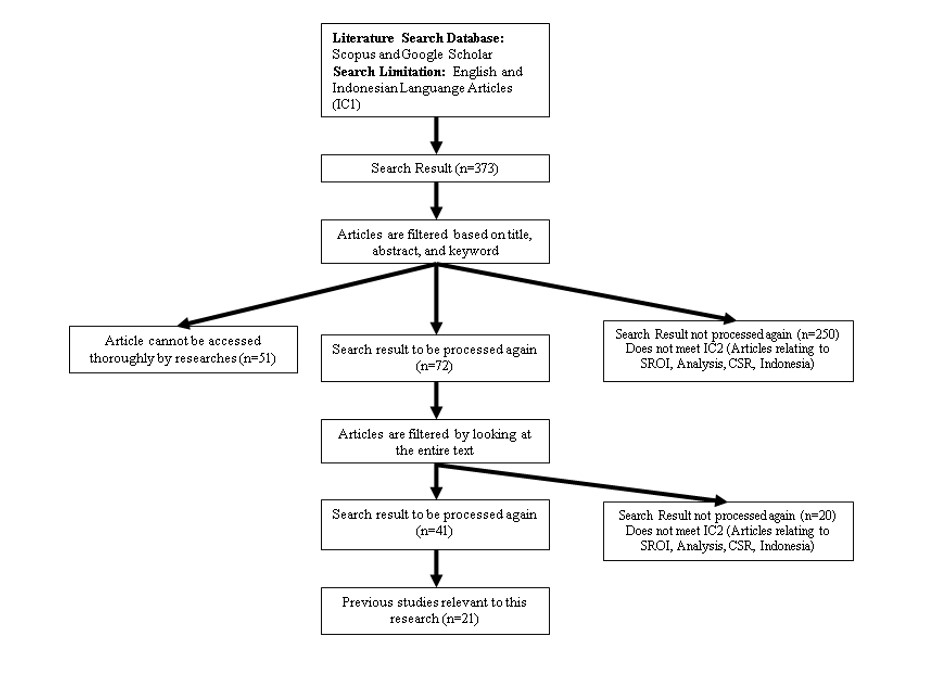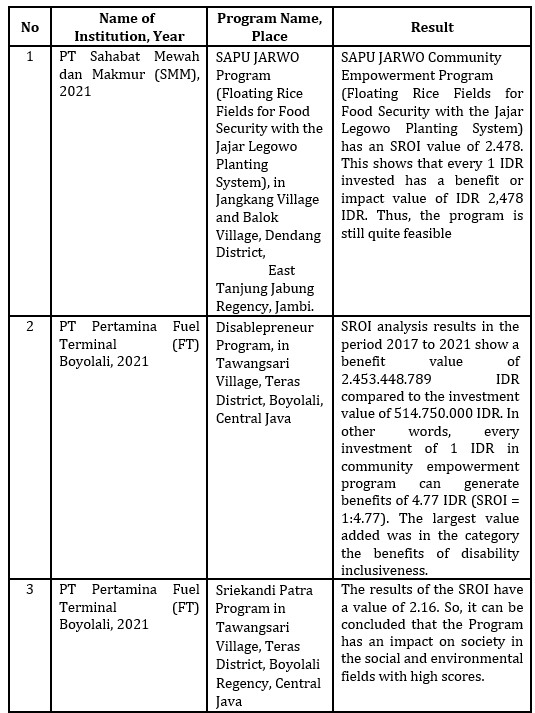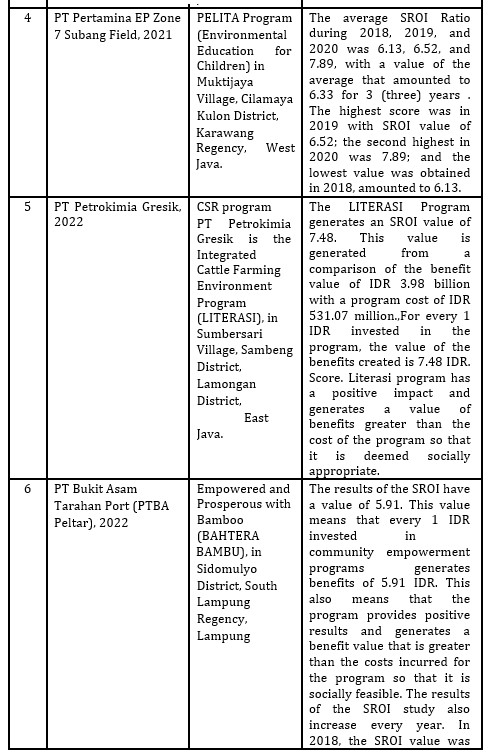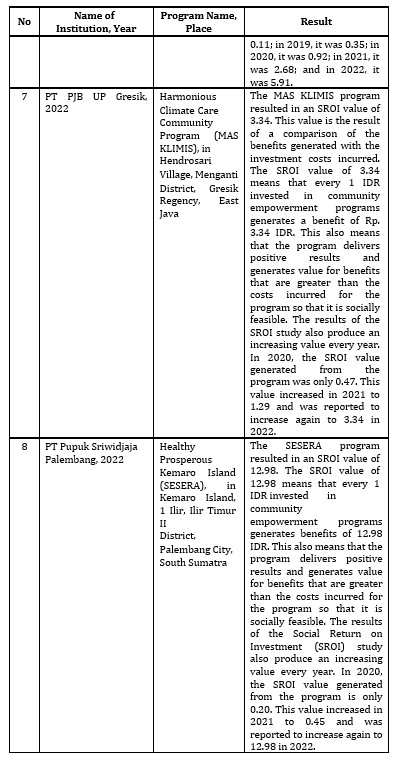Introduction
When running a business, economic actors are concerned with meeting the needs of their communities, making a profit, and fulfilling their social and environmental responsibilities (CSR). A company’s existence is inseparable from the community that surrounds it. The implementation of CSR in Indonesia is regulated by Law No. 40 of 2007 on Limited Liability Companies (PT). The law stipulates CSR as a social and environmental responsibility. This provision is further regulated by Decree No. 47 of 2012 on Social and Environmental Responsibility of Limited Liability Companies.
In 2021, the Ministry of Environment and Forestry (KLHK) will continue to innovate in the implementation of the Company Performance Rating Program in Environmental Management (PROPER) by introducing the latest criteria, namely Life Cycle Assessment (LCA) and Social Return on Investment (SROI). This is stated in the Regulation of the Minister of Environment and Forestry Number 1 of 2021 concerning PROPER (Media Indonesia, 2021). The PROPER program aims to strengthen companies environmental management capabilities and mitigate adverse environmental impacts. A PROPER assessment will provide the company with an image measured and determined in five colors: gold, green, blue, red, and black. The high PROPER rating indicates the company has taken above and beyond what the law requires regarding environmental management. Nurputri and Nuzula (2019) mentioned the Company Performance Rating Program (PROPER) can determine whether a company’s environmental performance is good or bad based on its accomplishments.
Ricciuti and Bufali (2019) and Perrini, Costanzo and Karatas-Ozkan (2021) mentioned compared to other social innovation evaluation methods such as Cost-Benefit Analysis (CBA), Cost-Effectiveness Analysis (CEA), and Cost-Benefit Analysis (CUA), SROI can comprehensively assess program financial performance and also measure social, environmental and economic value using representative monetization approaches. There are two types of SROI: Evaluative and Predictive. Bahri and Sulistiawati (2021) mentioned the SROI method is used to assess the impact of already implemented programs or activities. The SROI forecast type, on the other hand, estimates the impact of future programs or activities. Santoso et al (2019) mentioned impact measurement studies using evaluative and predictive SROI have the same principles and steps that are globally agreed upon. Although the impact of some social innovations is well measured by SROI, there is still little evidence of how CSR programs successfully develop communities, especially in Indonesia.
Based on previous research, study by Nusapati, Bahri and Bayinah (2020); Purnomo, Zaenal and Priyanti (2020); Prakasita and Fawzi (2022), the application of SROI can be applied to Educational Aspects; in the research by Dewi et al., (2021), Hasanuddin, Sukiman and Ichman (2021), the application of SROI can be applied to Agricultural Aspects; in a research by Kaneko and Matsumoto (2022), they show the application of SROI can be applied to Environmental Aspects; in a research by Putri, Hidayat and Gunawan (2022), the application of SROI can be applied to Aspects of
Community Development. There are few studies in Indonesia which use the SROI method in explaining research problems so that it becomes a gap in this research. This research aims to review existing research related to SROI, the application of SROI in Indonesia and the future direction of the application of SROI in Indonesia.
Method
This research is qualitative descriptive analysis research taking eight program forms beyond corporate compliance as case studies. The data were gathered through secondary data provided by PT Sahabat Mewah dan Makmur (SMM), PT Pertamina Fuel Terminal (FT) Boyolali, PT Pertamina EP Zone 7 Subang Field, PT Petrokimia Gresik, PT Bukit Asam Tarahan Port (PTBA Peltar), PT PJB UP Gresik, and PT Pupuk Sriwidjaja Palembang.
This research, also using a systematic literature review with recommended reporting items of the Preferred Reporting Items for Systematic Reviews and Meta-Analyses (PRISMA) method, is systematically conducted according to appropriate phases or study protocols. A systematic review is a research methodology aimed at evaluating, identifying, and analyzing all previous research related to a particular topic, study, or current phenomenon of concern.
The procedure for this systematic review according to Xiao and Watson (2019) consists of several steps:
- Formulation of the research question
- Development and validation of the review protocol
- Literature search
- Screening for inclusion
- Quality assessment
- Data Extraction
- Data Analysis and Synthesis
- Reporting of Results
Searching for the Literature
This research searches for relevant research articles with the same topic of this research conducted using keywords: Social Return on Investment, SROI, Corporate Social Responsibility, in Indonesia. To select articles, we use the following databases: Scopus and Google Scholar. Adjustments were made to the strategy used to find the articles, and the inclusion criteria were predetermined to maintain consistency in finding the articles and avoid possible bias.
Selection Criteria
Inclusion criteria used to guide the search and selection of articles are research in English and Indonesian languange (IC1), complete articles published in national and international journals in the 2018-2022 period, indexed data used and focused on Implementation Social Return on Investment (SROI) in Indonesia (IC2) (see Fig1). After getting a sample, the selected article then gets analyzed for the collection of relevant information. Analysis and synthesis of data extracted from the article are made descriptively to observe, describe, and classify data to gather knowledge generated from the themes explored in the meta-synthesis. Therefore, metasynthesis draws together the ideas which have been deconstructed during engagement with the three analytic meta-study components. Ronkainen, Wiltshire and Willis (2022) mentioned the aim at this stage should be to produce a new interpretation of a phenomenon, which is derived from analysing the data, method, and theory by which the phenomenon has been studied by others.

Fig 1. Prisma Flow Diagram Systematic Review
Based on Fig1, it can be seen that searches for relevant articles used databases from Scopus and Google Scholar in the 2018-2022 period. The search and selection process for articles examined in English and Indonesian (IC1) uses inclusion criteria. Based on a digital searches, data was found for 373 articles. A total of 51 articles could not be accessed after filtering based on title, abstract, and keywords using inclusion criteria relevant to the implementation of Social Return on Investment (SROI) in the analysis of the Corporate Social Responsibility (CSR) program in Indonesia (IC2). There were 250 articles excluded because they did not meet the inclusion criteria, and 72 articles could be processed. Article filtering was done by looking at the entire article and finding 21 articles that were relevant to this research.
Data Extraction, Assesing Quality of Primary Studies, and Data Synthetic
The source of data in this study is secondary data. Sugiyono (2018) mentioned secondary sources are sources that do not directly provide data to data collectors, for example through other people or through documents. This study obtained secondary data from journals, literature studies, literature related to research problems and other document information sourced from the Internet.
Result and Discussion
SROI Definition
Keane et al (2019) mentioned there are several social impact assessment tools, including social accounting and auditing, resource analysis, and social return assessment. One of the characteristics of SROI is that it mainly focuses on the social outcomes (e.g., well-being) of social activities for which no market values exist and includes several stakeholders’ perspectives.
Social Return on Investment (SROI) according to Menlhk (2021) is an approach to understanding and managing the impact of social, economic, and environmental values created by a program, activity or organization (social innovation). Suryani et al (2022) explain the meaning of SROI as a method for measuring the success of community empowerment programs through the impact of a program on the development of financial performance.
According to Nicholls et al (2012), there are two types of SROI:
- Evaluative, which is conducted retrospectively and based on actual outcomes that have already taken place;
- Forecast, which predicts how much social value will be created if the activities meet their intended outcomes. Forecast SROIs are especially useful in the planning stages of an activity. They can help show how investment can maximise impact and are also useful for identifying what should be measured once the project is up and running.Seven principles of SROI by Nicholls et al (2012):
- Stakeholder involvement: Involve stakeholders to communicate what to measure and how to measure and evaluate.
- Understanding what changes: Clarify how change occurs, evaluate this against the evidence you have collected, and identify positive and negative changes, intended and unintended.
- Appreciating important things: Use financial proxies so you can see the value of your results. Many results are not traded on the market and thus their value is not recognized.
- Focusing on including impact materiality: Determine what information and evidence should be included in the description to provide a true and unbiased view so that stakeholders can draw reasonable conclusions about the impact.
- Avoiding excessive claims: Claim only the value that the organization responsibly creates.
- Transparency: Indicate why the analysis is considered accurate and truthful, and indicate that the analysis is reported and discussed with stakeholders.
SROI analysis according to Nicholls et al (2012) involves six stages based on the above principles:
- Establishing scope and identifying stakeholders
The steps that must be taken are establishing scope, identifying stakeholders, and deciding how to involve stakeholders.
The steps starting on the impact map, identifying inputs, valuing inputs, clarifying outputs, and describing outcomes.
- Evidencing outcomes and giving them a value
The steps that must be taken are developing outcome indicators, collecting data of outcomes, establishing how long outcomes last, putting a value on the outcome
This stage consists of Deadweight and Displacement, Attribution, Drop-off, and calculating impact.
The steps starting on projecting into the future by calculating the Net Present Value (NPV) and the ratio. NPV is calculated using a formula: NPV= [Present value of benefits] – [ Value of investment]. Then, the SROI ratio is calculated using the formula:

Next, a sensitivity analysis test was carried out by calculating the payback period in months:
- Reporting, using, and embedding
This stage consists of reporting to stakeholders, using the results, and assurance.
SROI Practice in Indonesia
We collected several SROI reports for our analysis. The reports are as follows (see Table 1):
Table 1: SROI Implementation in Indonesia



Source: Processed secondary data, 2022
Based on the data from the eight programs above, it can be seen that measurements were carried out using the SROI. On average, the program produced an SROI value above 2. This means that the return generated is greater than what was invested in the program. So that it can be said that the program is feasible and the company as an investor has been successful because it has provided a social impact that benefits participants in their program.
Future Direction of SROI Practice in Indonesia
The direction of development of SROI implementation in Indonesia in the future will be more widespread. This is supported by the decision in the Minister of Environment and Forestry Regulation Number 1 of 2021 concerning feasibility; SROI includes new eligibility criteria to encourage environmental impact evaluation. The application of SROI is used in PROPER’s social innovation assessment and measures the success rate of social innovation. So, it can be said that companies that want to have a Corporate Performance Rating Assessment in Environmental Management or PROPER automatically use SROI criteria in measuring their programs.
Discussion
Based on the digital search, 373 articles were found in the predeterminate databases; 270 articles were excluded because they did not meet the inclusion criteria; 51 articles were not accessible; and 21 articles were relevant to this study. The following are articles from relevant previous research submissions. there are two types of SROI according to Nicholls et al (2012): Evaluative and Forecast.
Based on previous research conducted by Veronica (2020); Nurhazana, iznillah and Pianto (2021); Wijaya et al (2021); Fitriani et al (2022); Putri, Hidayat and Gunawan (2022); Suryani et al (2022); it is shown that Evaluative SROI was applied in BUMN Companies (State-Owned Enterprises). In the research by Khairunnisa, Pribadi and Prabowo (2019); Santoso et al (2019), 2020; Nusapati, Bahri and Bayinah (2020); Ayu Marsha and Matoati (2021); Dewi et al (2021); Hasanuddin, Sukiman and Ichman (2021); Riyadi et al (2022); Suryani et al (2022), it is shown that Evaluative SROI was applied in Private Companies. In a research study by Hastono and Ratnasari (2019), they show that Evaluative SROI was applied in Civil Society Organizations (CSO). According to the research by Habibi and Syamilah (2019); Oktamia, Zainuri and Azwari
(2020); Purnomo, Zaenal and Priyanti (2020); Prakasita and Fawzi (2022), it is shown that Evaluative SROI was applied in Islamic Philanthropy. In a research study by Silalahi, Santoso and Suliantoro (2018), they show that Evaluative SROI is also implemented in SMEs. It can be concluded that most of the SROI implemented in Indonesia is Evaluative SROI, used to measure or evaluate the program that has been running.
Prakasita and Fawzi (2022) mentioned that measurements using SROI are able to reveal the success and feasibility of the program well and are needed for the sustainability of the program in the future. However, Kaneko and Matsumoto (2022) mentioned that SROI method still needs evaluation in several aspects and needs to be further developed. Nusapati, Bahri and Bayinah (2020) mentioned that, in the future, SROI can be further developed in educational programs, as well as other fields such as economics, health, da’wah, and humanity.
Based on the eight SROI documents (see Table 2) that we analyzed, it appears that measurements have been made using SROI. The SROI value generated by the program is on average greater
than 2. The average SROI value greater than 2 indicates that, for every 1 IDR invested in community empowerment programs, benefits equal to or greater than 2 IDR are generated.
It can be concluded that the returns generated by the program are greater than those invested in the program. The program can be said to be feasible. Companies as investors have been successful in providing social impacts that benefit program participants. These companies are able to manage CSR well, because they are able to provide more impact than the value that has been invested.
In fact, several companies have implemented SROI for several years, where there is an increase in the value of the ratio from year to year. This shows that companies use this analysis as a method for evaluating the performance of CSR programs.
Conclusion
In conclusion, this systematic literature aims to identify and analyze trends, data sets, which are used in research to identify and predict SROI practices in Indonesia. Criteria based on inclusion and exclusion were designed, and articles were finally selected. This systematic literature review also raises a reflection on the lack of SROI implementation in Indonesia. Thus, there is a recommendation that there should be further development of SROI.
Limitations
The limitation of this research is the lack of analytical data which come from only eight BUMN companies’ (State Owned Enterprises) programs.
Recommendation
Based on government policy in the Regulation of the Minister of Environment and Forestry Number 1 of 2021 concerning PROPER, where the Ministry of Environment and Forestry (KLHK) added the latest criteria, namely Life Cycle Assessment (LCA) and Social Return on Investment (SROI) in implementing the Company Performance Rating Program in Environmental Management (PROPER). So, regarding future research, it would be useful to examine the use of SROI in non-profit organizations to see if they use similar methods to evaluate the success of their social activities.
References
- Marsha, AA and Matoati, R. (2021) ‘Penilaian Dampak Investasi Sosial Pelaksanaan CSR PT. Catur Elang Perkasa Menggunakan Metode Social Return On Investment (SROI)’, SAINS: Jurnal Manajemen dan Bisnis, 14 (1), 87-109.
- Bahri, E.S. and Sulistiawati, S. (2021) ‘Identification of Zakat Impact Measurement Tools’, AKTSAR: Jurnal Akuntansi Syariah, 4(1), 50. Available at: https://doi.org/10.21043/aktsar.v4i1.9052.
- Dewi, Y.(2021) ‘Social Return On Investment (SROI) Analysis in Empowering Pepper Farmers Program in Petaling Banjar Village Social Return On Investment (SROI)’, Community Development Journal, 5(3).
- Fitriani, T., Widodo, WE., Abriandi, E, and Fadhlillah, DF. (2022) ‘Analisis dampak Program Pemberdayaan Masyarakat “Kopi Kang!” dengan Menggunakan Social Return on Investment (SROI)’, Jurnal Pendidikan dan Konseling, 4(5), 2516-2525.
- Habibi, U and Syamilah, N. (2019) ‘Dampak Penyaluran Dana Ziswaf (Zakat, Infaq, Sedekah dan Wakaf) pada Program Pendidikan STID Mohammad Natsir berdasarkan Social Return On Investment’, Jurnal Bina Ummat: Membina dan Membentengi Ummat, 2(01), 1-26.
- Hasanuddin, H., Sukiman, S, and Ichman, L.M. (2021) ‘Method of Social Return On
- Investment (SROI) on Social and Environmental Responsibility in Sustainable Environmentally Friendly Healthy Agriculture Program Sri Organic PT Vale Indonesia Tbk’, European Journal of Research Development and Sustainability, 2(12), 26-36.
- Hastono, D.W. and Ratnasari, M. (2019) ‘Social Return on Investment (SROI) for Civil
- Society Organization (CSO) in Indonesia (A Case Study of Rumah Dongeng Pelangi)’, in Advances in Economics, Business and Management Research. 202-205.
- Kaneko, A. and Matsumoto, T. (2022) ‘Application of the Social Return on Investment for
- Onsite Wastewater Treatment Systems in the Republic of Indonesia’, Journal of Environmental Information Science, 2022 (1),1-11.
- Keane, L., Hoare, E., Richards, J., Bauman, A, and Bellew, W. (2019) ‘Methods for quantifying the social and economic value of sport and active recreation: a critical review’, Sport in Society, 22(12), 2203-2223.
- Khairunnisa, K., Pribadi, A.B, and Prabowo, F.S.A. (2019) ‘Analysis of Social Return on
- Investment (SROI) to Measure The Social, Environment, and Economics Impact on The National Fattening Sheep Program (Studi at Pesantren Al-Ittifaq)’, Jurnal Ilmu Sosial, Politik & Humaniora (JISRA), 2(2), 33-42.
- Media Indonesia., (2021), Kriteria Baru Proper 2021 Dorong Evaluasi Dampak
- Lingkungan.[Online], [Retrieved November 7, 2022],
- https://mediaindonesia.com/humaniora/410810/kriteria-baru-proper-2021-dorong-evaluasidampak-lingkungan.
- , (2021), PERMENLHK No 1 Tahun 2021 Tentang PROPER.[Online], [Retrieved November 7, 2022], https://proper.menlhk.go.id/proper/berita/detail/330.
- Nicholls, J., Lawlor, E. and Neitzer, E. (2012) A guide to Social Return on Investment, Cabinet Office.
- Nurhazana,N., Iznillah, ML, and Pianto, SR. (2021) ‘Dampak Program CSR Binaan PT Pertamina RU II Sungai Pakning: Analisis Social Return on Investment (SROI) dan Sensitivitas’, Jurnal Akuntansi dan Ekonomika, 11(2), 203–212.
- Nurputri, B.A. and Nuzula, N.F. (2019) ‘Penerapan Proper (Program Penilaian Peringkat Kinerja Perusahaan dalam Pengelolaan Lingkungan Hidup) dalam Kinerja Lingkungan di
- PLTGU Tanjung Batu (Studi pada Pengendalian Pencemaran Air)’, Jurnal Administrasi Bisnis , 67(1), 25-34.
- Nusapati, A.I., Bahri, E.S, and Bayinah, A.N. (2020) ‘The Measurement of Social Value Impact of Ziswaf Using Social Return on Investment Model at Smart Ekselensia Indonesia’, Journal of Islamic Economics, 12(1).
- Oktamia, D., Zainuri, A. and Azwari, P.C. (2020) ‘Social Return on Investment pada Program Ekonomi Local Business Development Dompet Dhuafa Sumatera Selatan’, Intizar, 26(2), 6572.
- Perrini, F., Costanzo, L.A. and Karatas-Ozkan, M. (2021) ‘Measuring impact and creating change: a comparison of the main methods for social enterprises’, Corporate Governance (Bingley), 21(2), 237–251.
- Prakasita, D.B. and Fawzi, I.L. (2022) ‘The Analysis of Social Impact of Indonesia Teaching Fellowship (ITF) Teacher Training Program By Ruangguru and Bakti Kominfo in Sorong Using the Social Return on Investment (SROI) Method’, Journal Research of Social, Science, Economics, and Management, 1(9), 1293–1301.
- Purnomo, C., Zaenal, M.S. and Priyanti (2020) ‘Impact Measurement of LGBT Handling and
- Prevention Training Program in Schools, Denpasar, Bali with Social Return on Investment (SROI) Methods’, International Journal of Zakat and Islamic Philanthropy , 2(1), 59–66.
- Putri, D.T., Hidayat, I. and Gunawan, Y. (2022) ‘Economics Development Analysis Journal Social Return on Investment of PT Badak NGL SALIN SWARA Program Article Information’, Economics Development Analysis Journal, 11(3), 284-93.
- Ricciuti, E. and Bufali, M.V. (2019) ‘The Health and Social Impact of Blood Donors Associations: A Social Return on Investment (SROI) Analysis’, Evaluation and Program Planning, 73, 04–213.
- Riyadi, S.F., Fedryansyah, M., Santoso, M.B., Humaedi, S., Chairin, R.O.P., Darmawan, E., Putra, A. and Pratama, R.A. (2022) ‘Evaluasi Social Return on Investment (SROI) pada Program Pantai Piwang Kabupaten Natuna’, Takzim : Jurnal Pengabdian Masyarakat, 2(1),18–29.
- Ronkainen, N., Wiltshire, G. and Willis, M. (2022) ‘Meta-Study’, International Review of Sport and Exercise Psychology, 15(1), 226–241.
- Santoso, M.B., Adinegara, R., Ismanto, S.U., Mumajad, I. and Mulyono, H. (2019) ‘Assesment of the Impact of CSR Implementation Social Investment Using Social Return on Investment (SROI) Methods’, AdBispreneur: Jurnal Pemikiran dan Penelitian Administrasi Bisnis dan Kewirausahaan, 3(2), 153.
- Santoso, M.B., Raharjo, S.T., Humaedi, S. and Mulyono, H. (2020) ‘Social Return on Investment (SROI) Program “Sentra Industri Bukit Asam” (SIBA) Dusun Batik Kujur Tanjung Enim’, Jurnal Pemikiran dan Penelitian Administrasi Bisnis dan Kewirausahaan, 5(1), 15-29.
- Silalahi, D.C.G., Santoso, H. and Suliantoro, H. (2018) ‘Analisis Social Return on Investment pada Kewirausahaan Sosial: Studi Kasus di Upreneur Aiesec Undip’, Industrial Engineering Online Journal, 7(2).
- (2018) Metode Penelitian Kuantitatif, Kualitatif, dan R&D,Bandun, Alfabeta.
- Suryani, R., Silfiana, A., Lathifah, N. and Ikhlas, N. (2022) ‘Jurnal Presipitasi Measuring the
- Effect of Kampong AMOI Program on Sustainability Factors using Social Return on
- Investment Method: A Case Study of Riding Panjang Village, Bangka Barat’, Jurnal Presipitasi , 19(1), 190–198.
- Astuti, V.S (2020) ‘Analisis SROI (Social Return on Investment) dalam Mengukur Keberhasilan Program CSR Mikrohydro oleh PT. PJB Up Paiton di Desa Andungbiru, Kabupaten Probolinggo’, Jurnal Ilmiah Politik, Kebijakan, & Sosial (Publicio), 2(2), 15-22.
- Wijaya, O., Susanto, D.A., Rozaki, Z. and Nurhidayati, A.P. (2021) ‘Dampak Investasi Sosial Pelaksanaan Corporate Social Responsibility(Csr) terhadap Pengembangan Agribisnis Jamur dengan Pendekatan Social Return on Investment (SROI)’, Jurnal Ekonomi Pertanian dan Agribisnis (JEPA), 5(4), 1270-1279.
- Xiao, Y. and Watson, M. (2019) ‘Guidance on Conducting a Systematic Literature Review’, Journal of Planning Education and Research. SAGE Publications Inc.,39 (1), 93–112.







